Welcome to the definitive guide to the best things to do in Stuttgart, a city known for its remarkable blend of cultural vibrancy, innovative industries, and rich history. In this article, I’ll be sharing the top must-see attractions and hidden gems that contribute to Stuttgart’s unique charm.
Stuttgart, nestled in Germany’s southwest region, has long been synonymous with automotive excellence, housing the headquarters of both Mercedes-Benz and Porsche. But beyond its revved-up reputation, the city offers a tapestry of experiences, from its lively public squares and lush green parks to its world-class museums and historical palaces.
Whether you’re an art enthusiast, a nature lover, or an automotive fanatic, Stuttgart has something to pique your curiosity and capture your imagination.
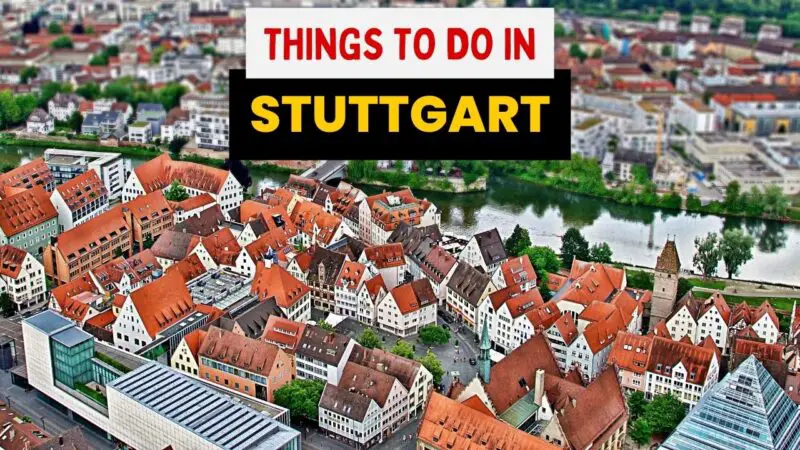
During my time exploring this dynamic city, I’ve been captivated by the surprising diversity of its attractions. The architectural beauty of the Schlossplatz, the innovation on display at the Turmforum, and the natural respite within the Schlossgarten – each place offers its own story and contributes to the rich cultural narrative of Stuttgart.
So, let’s dive into this eclectic mix of activities that make Stuttgart an unmissable stop on any traveler’s itinerary.
Love Germany? Click here to download your free guide to ALL of Germany’s Amazing UNESCO sites. See all 52 of them!
A Brief History of Stuttgart
Stuttgart, the capital of the state of Baden-Württemberg in southern Germany, boasts a rich history that traces back to ancient times. Its roots stretch to the 10th century when it began as a horse breeding farm – ‘Stuotgarten’ – which directly translates to ‘stud garden.’ This name appropriately reflected the area’s original purpose and indicative of the agricultural nature of the early settlement.
Over time, Stuttgart’s favorable location within the fertile Neckar river valley allowed it to flourish as a market town. By the late Middle Ages, it had grown significantly and became a center of vineyard cultivation, a tradition which continues to color the region’s culture and economics to the present day.
The 14th and 15th centuries marked Stuttgart’s rise as a residence of counts and dukes; it became the ducal seat of the Counts of Württemberg, who transformed it into a principal residence of their territories.
The early modern period brought about significant transformations. Stuttgart saw the establishment of a duchy in 1495, which soon rose to a kingdom by 1806. During this time, the city began to adopt a more cosmopolitan character, attracting scholars, artists, and architects, which greatly contributed to Stuttgart’s cultural development.
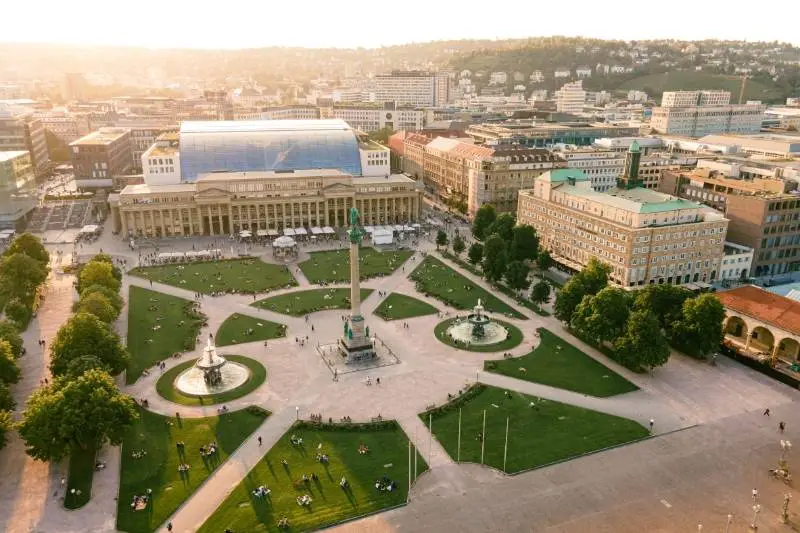
The city became part of the German Empire in 1871 and enjoyed further growth with the industrial revolution’s arrival, particularly with the emergence of the automotive industry – Mercedes-Benz and Porsche have their roots in Stuttgart, affirming the city’s title as the “Cradle of the Automobile.”
Devastated during World War II due to its industrial significance, Stuttgart was heavily bombed and had to be extensively rebuilt in the post-war years. It emerged from these ashes and underwent rapid reconstruction, which saw the incorporation of modernist architectural ideals and public facilities.
With the post-war economic miracle, Stuttgart experienced tremendous growth and became a vibrant hub of engineering, high-tech industries, and information technology. Furthermore, Stuttgart’s celebrated cultural institutions, like the State Gallery and State Theatre, contribute to its rich cultural tapestry, paralleling its storied history with a dynamic, forward-looking perspective.
The fusion of its historical legacy with modern innovation makes Stuttgart a distinctive and thriving European city with a deeply rooted historical identity.
Top 15 Incredible Things To Do In Stuttgart
These things to do in Stuttgart are somewhat in geographical order starting with the closest to the center of Stuttgart then working our way out.
So you can see where they are, the majority of places to visit in Stuttgart mentioned here are on this map.
The attractions in Stuttgart are spread out so you’ll need to use public transport or a car to see them all. I also mentioned some great half- and full-day trips that you can take from Stuttgart. You can take these using public transport or a car easily.
1. Take a Stroll in the Schlossplatz
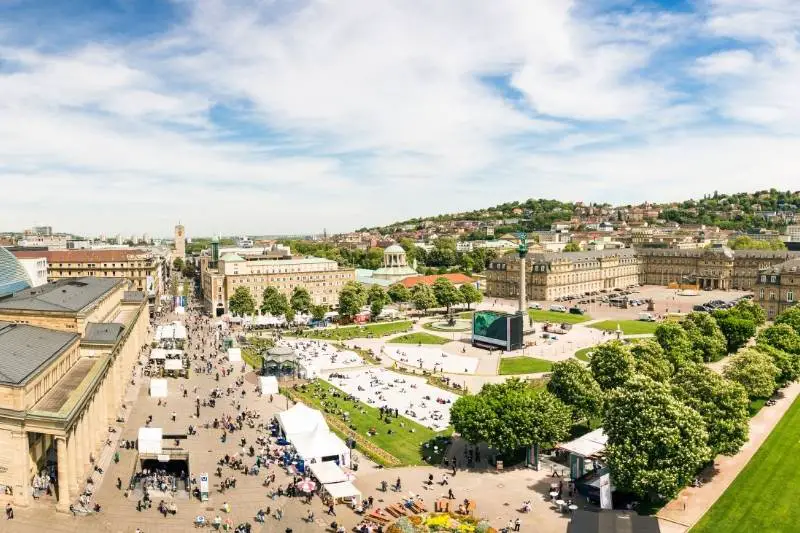
Schlossplatz is the grand centerpiece of Stuttgart, a sweeping square that instantly communicates the city’s blend of regal history and vibrant contemporary life. Framed by the majestic facade of the New Palace, constructed in the late 18th century as a royal residence, the Schlossplatz is a place where past and present seamlessly converge.
Visitors to Schlossplatz are greeted by expansive green lawns, fountains, and seasonal floral displays that invite relaxation and recreation. The square is the site of numerous public events, including open-air concerts, markets, and festivals, making it a lively spot at nearly any time of year.
Whether lounging on the grass on a sunny day, admiring the classical architecture, or enjoying a cup of coffee at one of the bordering cafes, Schlossplatz offers a prime vantage point from which to experience the pulse of Stuttgart. In winter, it’s home to an enormous Christmas market.
Here, history, culture, and urban life dance a continuous waltz, making it an essential experience for any visitor to the city. It’s the perfect place to start your Stuttgart adevnture.
2. Learn at InfoTurmStuttgart
InfoTurmStuttgart (ITS) provides a unique insight into one of Stuttgart’s most innovative and sustainable urban development projects – Stuttgart 21. Perched atop one of the city’s few high-rise structures, visitors to ITS are greeted with panoramic views that span the bustling Swabian metropolis and offer a glimpse into the evolving landscape of the railway infrastructure.
As you journey through the exhibition housed within the tower, there’s an educational exploration awaiting all ages. The intricate models and informative displays meticulously detail the project’s complexity, emphasizing sustainable concepts and modern engineering prowess. It’s not just a view from above but a comprehensive narrative of urban transformation and technological advancement.
Interactive elements and multimedia installations ensure that the experience is engaging, making the intricacies of urban planning accessible. Whether you’re an architecture buff, engineering enthusiast, or simply curious about urban development, a visit to InfoTurmStuttgart enriches your understanding of Stuttgart’s ambitious vision for its future.
You can find InfoTurmStuttgart at platform 16 in the main train station. Entry is free and there are long opening hours so there is no reason not to pop in. At the very least, head up to the top for the great views.
Find more information here.
3. Immerse Yourself in Kunstmuseum Stuttgart

The modernist marvel of the Kunstmuseum Stuttgart, an architectural standout with its bold cubic glass design, is more than a structure; it is a canvas displaying the city’s commitment to contemporary art.
Opened in 2005, the museum has rapidly evolved into a cultural landmark. Its strategic position in the city’s heart, close to the Schlossplatz, makes it easily accessible and a striking visual counterpoint to the area’s more historic buildings.
Its notable collection focuses on works from the 20th and 21st centuries, providing a rich overview of the significant artistic movements from this period, with particular emphasis on Constructivism, Concrete Art, and the works of Otto Dix.
You can expect to find a dynamic array of temporary exhibitions alongside the permanent collection, offering a continually fresh artistic experience. More than just a passive observational journey, many pieces challenge visitors to reflect on social and political issues, bridging the gap between art and viewer engagement.
If you want a meal with a view, try the Cube Restaurant here.
4. Visit the Landesmuseum Württemberg (Württemberg History Museum)
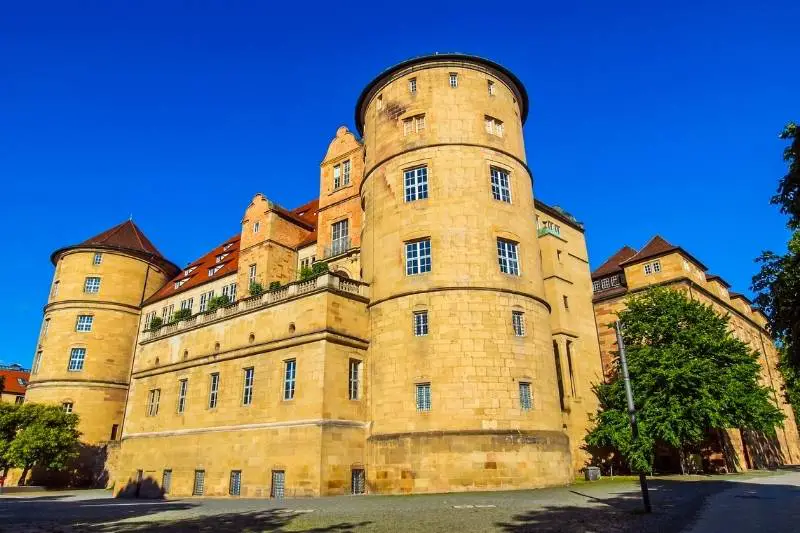
The Landesmuseum Württemberg is housed in the Old Castle (Altes Schloss), a building whose history stretches back to the 10th century and has witnessed the evolution of Stuttgart from its days as a medieval duchy to a modern city.
This museum is imbued with the soul of the region, providing an extensive narrative of Württemberg’s rich past through a collection that ranges from prehistoric findings to medieval artifacts and royal treasures.
Archaeology enthusiasts will revel in the prehistory and proto-history collections, where they can delve into the lives of the region’s earliest inhabitants. The medieval collections paint a vivid picture of courtly life with their assortment of arms, armor, and coins, while the Renaissance art on display speaks to an age of splendor and innovation.
The crown jewels of the Württemberg kings offer a glimpse into the opulence and power of the monarchy.
More information here.
5. Discover the Art at the Staatsgalerie Stuttgart
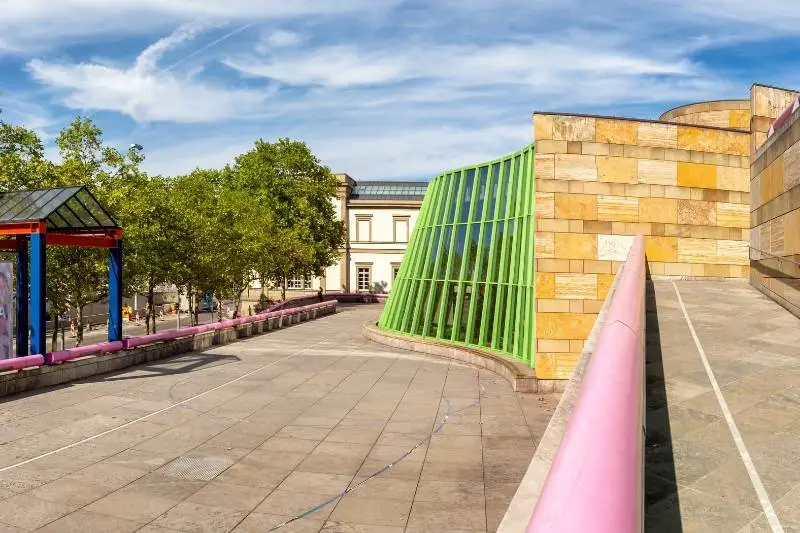
The Staatsgalerie Stuttgart is a hallmark of the city’s cultural landscape, a museum where the breadth of artistic expression from the 14th century to today is on full display.
Founded in 1843, it has grown into one of Europe’s most visited museums, renowned for its expansive collection of European art, including a particularly rich array of works from German Renaissance painters like Albrecht Dürer and Hans Holbein.
Beyond the Renaissance, you can explore movements such as the Baroque, Romanticism, and the modern art of the 20th century, with pieces by Picasso, Matisse, and Salvador Dalí. The museum has a significant focus on German Expressionists and houses a thoughtfully curated selection of contemporary works.
Educational programs, guided tours, and special exhibitions make the Staatsgalerie Stuttgart an engaging center for both learning and enjoyment. Art connoisseurs and casual visitors alike will find the museum’s marriage of historical depth and contemporary insight a compelling reason to include it on any Stuttgart itinerary.
6. Relax in the Schlossgarten
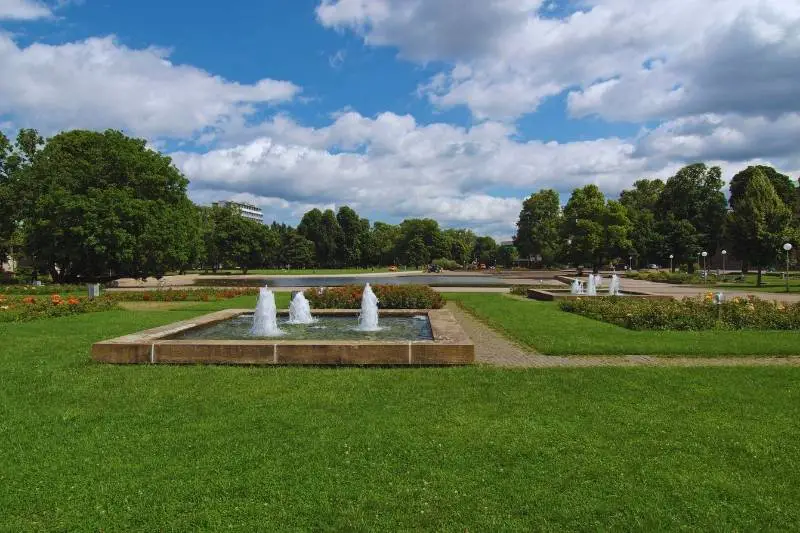
The green heart of Stuttgart, Schlossgarten, connects the urban space with nature, offering locals and tourists alike a verdant oasis stretching from the central Schlossplatz to the River Neckar. The series of interconnected gardens date back to the 14th century when they served as a ducal park.
Over the years, these gardens have evolved, surviving extensive damage during World War II to become the picturesque public space we see today. They are a key piece of Stuttgart city life, full of sculpted landscapes, water features, and paths that wind through expansive lawns and shady groves of trees.
You can wander through the three distinct sections of the park, each marked by an era and style of garden design. From the baroque influence of the Upper Garden to the English style of the Middle and Lower Gardens, each section encapsulates different historical aesthetics.
The gardens are a sanctuary for both reflecting and engaging in recreational activities – you can find joggers, picnickers, and families enjoying this beautiful slice of nature.
7. Enjoy the Views from the Fernsehturm Stuttgart (TV Tower)

Standing over the forests, fields, and vineyards that cradle Stuttgart, the Fernsehturm Stuttgart is more than a television tower; it’s an emblem of the city’s innovative spirit. Erected in 1956, the tower stands at a height of 217 meters and was the first TV tower in the world.
The Fernsehturm set an architectural and technological precedent for subsequent TV towers across the globe and remains a point of pride for Stuttgart.
Ascending the tower’s sleek, tapered structure is the thing to do in Stuttgart for amazing views. You’ll arrive at an observation platform that offers unparalleled, sweeping views of the Stuttgart region.
Beyond the impressive landscape, guests can also visit an exhibition detailing the tower’s construction and significance. Taking in the 360-degree panorama, cast your eyes over the expanse of the Swabian Jura, the Black Forest, and the cityscape of Stuttgart. With a restaurant at as well, the Fernsehturm Stuttgart is a literal high point for any visitor.
It’s easy to get here on the U-bahn from central Stuttgart.
8. Laugh and Learn at the Schweine Museum Stuttgart
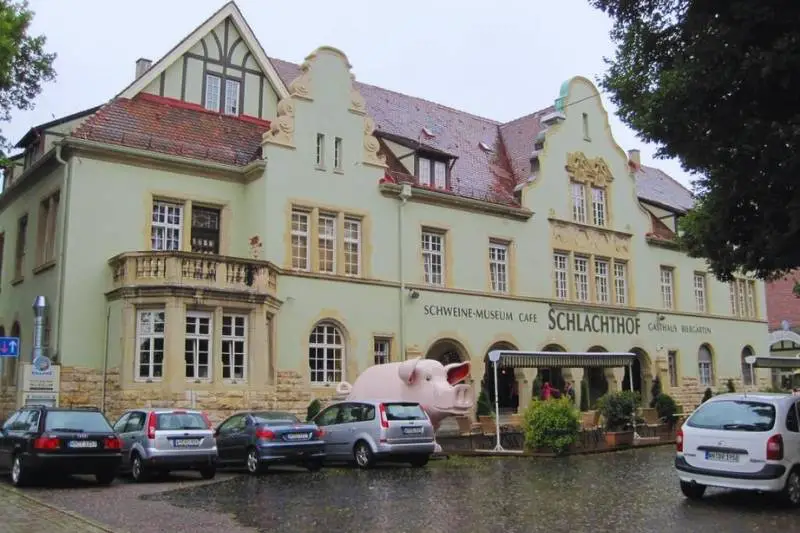
Located near the Neckar River, the Schweine Museum stands unique as the world’s largest museum dedicated to all things pig. With over 50,000 exhibits across more than two dozen themed rooms, the museum presents a comprehensive journey through the cultural, artistic, and social significance of pigs throughout history.
The museum is housed in a historical slaughterhouse, repurposed into a charming space that combines serious education with quirky fun. Children and adults are both entertained and informed by the idiosyncrasies of such a focused collection, from piggy banks and toys to works of art and artifacts.
While exploring the humorous world of pigs, you are also treated to little-known facts about swine biology and the animal’s importance in agriculture and ecology. The Schweine Museum provides an exceptional, albeit unconventional, experience, adding an enriching layer to Stuttgart’s cultural offerings.
It’s easy to get here on the U-bahn from central Stuttgart.
9. Visit the Mercedes-Benz Museum
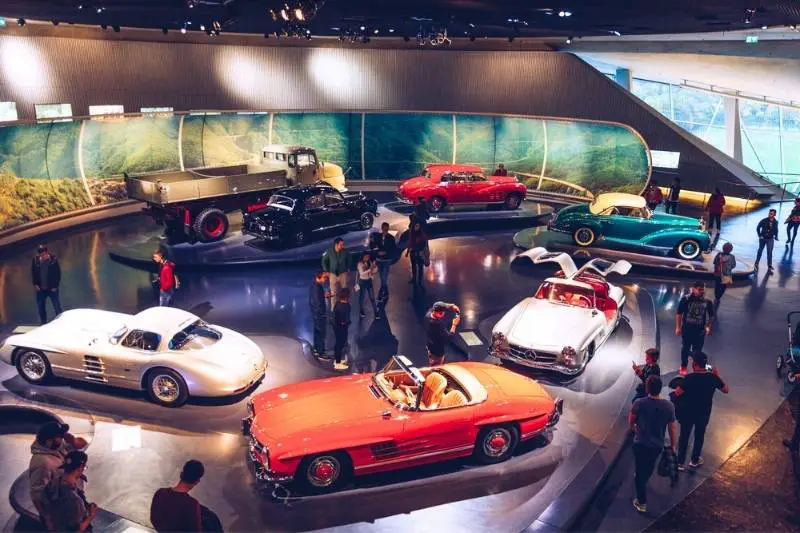
The Mercedes-Benz Museum is a historical tour de force in the realm of automotive museums. With a striking double helix design, the museum narrates the story of Mercedes-Benz – one of Stuttgart’s and the world’s most iconic car brands – beginning from its creation in 1886.
The museum showcases not just the evolution of the brand, but also the technological progress and societal changes that vehicles have ushered in over more than a century.
Across nine levels and nearly 17,000 square meters of exhibition space, you can admire over 160 vehicles, including some of the oldest cars ever built, legendary racing cars, and futuristic research vehicles.
Through multimedia exhibits, the museum dives into diverse thematic areas such as “Mythos Rooms”, which highlight the brand’s history in beautiful, chronologically arranged displays, and the “Fascination of Technology”, offering an interactive insight into the design and technology of Mercedes-Benz.
The Mercedes-Benz Museum goes beyond a conventional car exhibit; it stands as a microcosm of industrial history and an immersive testament to an iconic brand’s legacy. It’s a must for anyone with even a passing interest in cars.
It can be reached on the S-bahn along with a short walk.
10. Wander Through the Wilhelma Zoo and Botanical Gardens
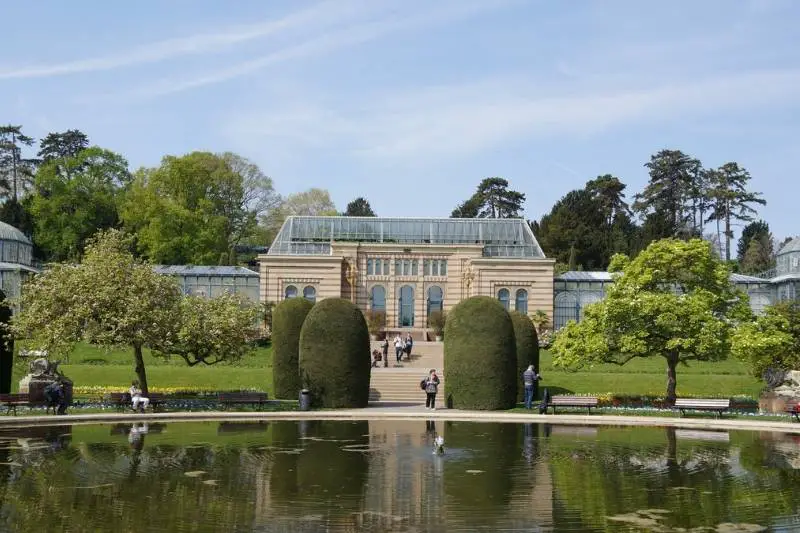
Wilhelma Zoo and Botanical Gardens provide one of the most diverse biological experiences in Europe. Originally built as a private royal retreat in Moorish style, it now combines a love for nature and a passion for species preservation. As Germany’s only zoological-botanical garden, Wilhelma boasts of more than 1,200 species and over 7,000 varieties of plants within its 30-hectare grounds.
The zoo component allows you to encounter animals from all over the world, from apes to zebras, in enclosures that mimic natural habitats. Highlights include the Amazon House, Aquarium, and the award-winning Ape House. In contrast, the botanical gardens bring to life the flora of the world, from local native species in the historic arboretum to exotic plants found in the greenhouses.
The gardens also present historical landscaping, including a formal garden set against the backdrop of the original Moorish villa. The meticulous care put into the conservation of both plant and animal life speaks to the garden’s broader ecological vision.
11. Explore the Porsche Museum

The Porsche Museum is an architectural marvel and a vibrant testament to Stuttgart’s automotive legacy, celebrating the history and excitement of the Porsche brand. Opened to the public in 2009, the museum features a futuristic design that seems to float above the ground, mirroring the forward-thinking ethos of the company it represents.
Inside, you are transported into the world of high-performance vehicles with more than 80 exhibits that include iconic road and racing cars.
Each vehicle on display at the Porsche Museum has been meticulously restored and is presented as a functional piece of art, representing a chapter in the narrative of automotive progress and design elegance. Interactive exhibits trace the company’s origins from the dream of Ferdinand Porsche to the international conglomerate it is today.
The museum also offers a window into the future of the brand with prototypes and concept cars. For enthusiasts and novices alike, a visit to the museum is an opportunity not just to see, but to experience the passion and innovation that define Porsche.
You can also book a tour through the factory. Find more information here.
You can get here on an easy ride on the S-bahn.
12. Explore Schloss Solitude
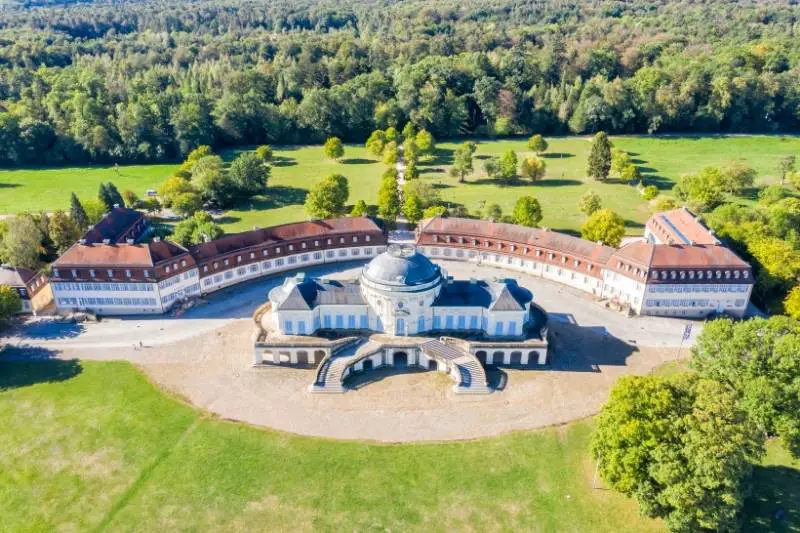
Situated amidst the serene forests west of Stuttgart, Schloss Solitude stands as a quiet ode to the rococo period’s whimsy and luxury. This 18th-century palace, commissioned by Duke Carl Eugen of Württemberg, once served as a hunting lodge and a place of courtly entertainment.
Its name, translating to ‘solitude’ or ‘seclusion,’ captures the castle’s initial purpose as a retreat from the demands of ducal reign and courtly life.
Today, Schloss Solitude is both a historical site and a cultural nexus, home to the Akademie Schloss Solitude which supports young artists with residency programs. You can explore elegantly furnished rooms that recapture the essence of the rococo era, with its ornate decorations and delicate pastel colors.
The castle provides a panoramic view stretching from the northern Black Forest to the Swabian Alps, making it a picturesque destination for history buffs, art enthusiasts, and nature lovers alike.
You can only go inside the castle on a guided tour which is currently only in German. Find more information here.
13. Half-Day Trip to Esslingen
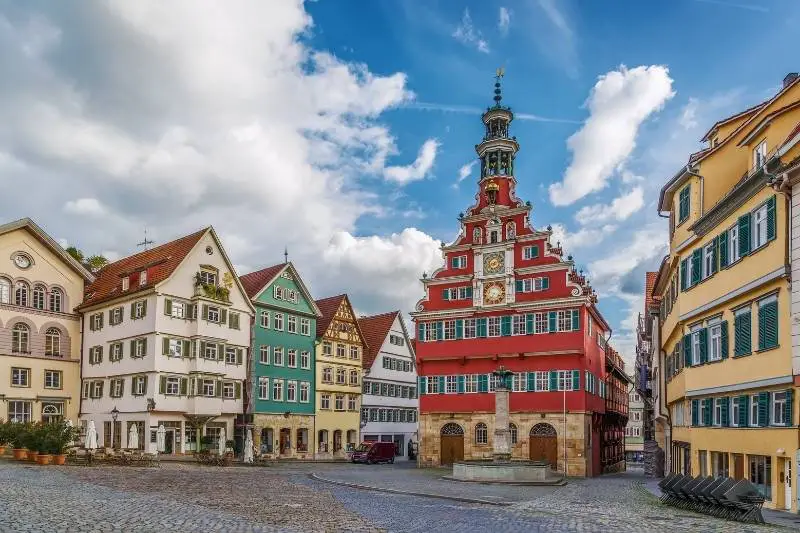
A trip to Esslingen am Neckar is like stepping through the pages of a history book into a world where medieval life is preserved amidst the bustle of modernity. Located just southeast of Stuttgart, this town is a treasure trove of historical architecture, with its roots dating back over a millennium.
The medieval cityscape is characterized by winding cobblestone alleys, ancient timber-framed houses, and a striking fortress that overlooks the town.
A half-day excursion to Esslingen offers the chance to visit the Burg Esslingen, a castle complex providing splendid views, and to explore the oldest row of half-timbered houses in Germany at the Stadtmuseum im Gelben Haus.
The town’s interesting past as a free imperial city is vividly on display as you wander through the historic market place or visit the Old Town Hall with its impressive astronomical clock. With its rich patina of history and well-preserved structures, Esslingen am Neckar provides an enchanting glimpse into Germany’s medieval era.
The best news is that it’s only a nine minute train ride from Stuttgart.
I like Esslingen so much that I stayed in Esslingen and used it as my base to explore Stuttgart. It is easy to do this.
Read our full guide to Esslingen and all its attractions here.
14. Half-Day Trip to Ludwigsburg
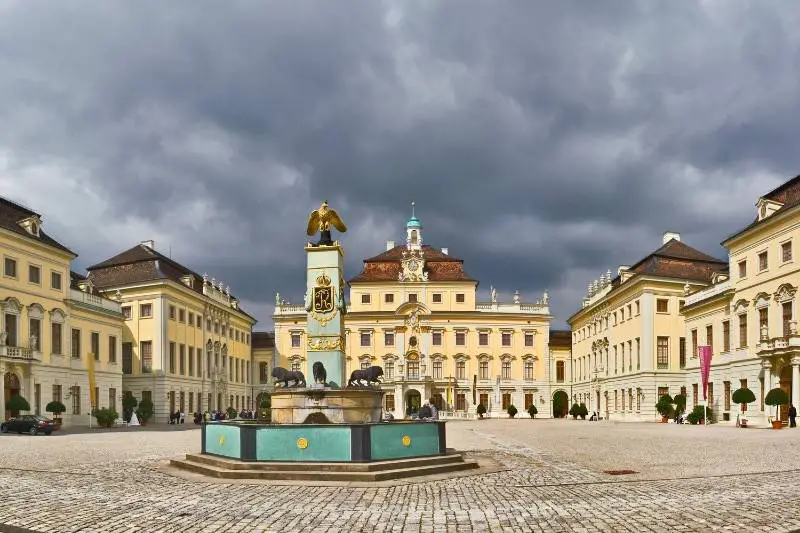
The allure of Ludwigsburg lies in its spectacular 18th-century Ludwigsburg Palace, a symbol of the town’s grand past. Known as the “Swabian Versailles,” it is one of the largest Baroque palaces in Germany, designed as a symbol of ducal power and splendor. A half-day trip to Ludwigsburg invites you to step back in time and experience the lavish lifestyles of the former Württemberg royalty.
Beyond the impressive architecture and opulent rooms of the palace, the appeal of Ludwigsburg is magnified by its pristine Baroque gardens, which seamlessly blend art, nature, and history. The Fairy-Tale Garden, adorned with enchanting sculptures and interactive installations, appeals to young visitors and adds a whimsical touch to the palace grounds.
Despite its relatively compact size, Ludwigsburg delivers a culturally rich and visually spectacular experience.
Ludwigsburg is also only a nine minute train ride from Stuttgart.
Read our full guide to Ludwigsburg and all its attractions here.
15. Day Trip to Tübingen
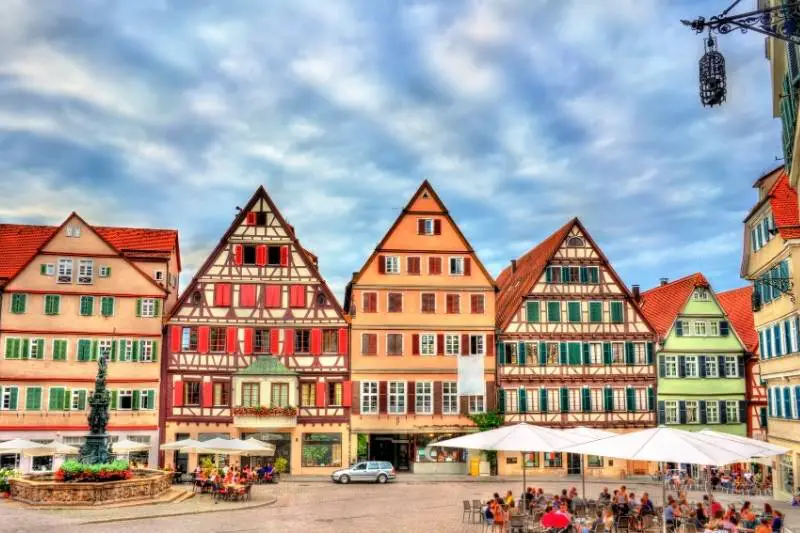
The university town of Tübingen offers a charming blend of intellectual vibrancy and preserved historical character, making it a rewarding escape from Stuttgart. The prestigious Eberhard Karls University, one of the oldest in Germany, infuses Tübingen with a sense of youthful energy and academic tradition.
A wander through the old town reveals cobbled lanes, half-timbered houses, and the Stiftskirche, with its panoramic views from the tower. It did not receive much damage in World War II so much of what you see is original (and oh so beautiful).
Tübingen is beautifully set along the Neckar River, and one of the town’s signature experiences is a punt boat ride, evoking a sense of timelessness. You can explore the Hohentübingen Castle, home to the university’s museum which boasts art and cultural artifacts dating back to the ancient world. Cafes and bookshops abound, fostering a relaxed but intellectual atmosphere.
Whether meandering by the scenic riverfront or delving into the academic legacy of the university, a day trip to Tübingen is both rejuvenating and culturally enriching.
You can be in Tübingen in 43 minutes on the train.
Read our full guide to Tübingen and all its attractions here.
If you are in Stuttgart in September/October, don’t miss Cannstatter Volksfest, the second largest beer festival in the world (after Oktoberfest). Read more about it here.
How To Get To Stuttgart
Imagine you want to discover Stuttgart, the cradle of the automobile and a jewel of southwestern Germany. Fortunately, no matter where you are in Germany, getting to Stuttgart is a breeze.
If you’re starting from Berlin, board the high-speed ICE (Intercity-Express) train. In just under six hours, you’ll glide through picturesque landscapes and cutting-edge cities before arriving in Stuttgart Hauptbahnhof, the city’s central station.
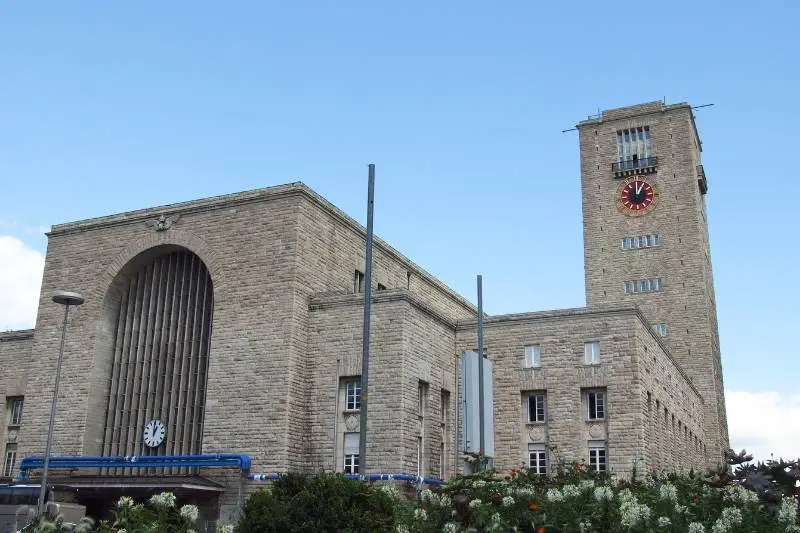
Should you find yourself in Munich, the ICE or regional trains offer a scenic two-hour journey to Stuttgart. Windows reveal rolling valleys and the patchwork of the German countryside, transporting you directly into the heart of Stuttgart.
From Frankfurt, an even swifter experience awaits. In a mere ninety minutes, the ICE train connects Germany’s financial hub with the Baden-Württemberg capital. It’s fast, efficient, and gives you more time to explore.
Wherever you are in Germany, you’ll be able to get to Stuttgart by train.
Click here to check out Deutsche Bahn schedules and prices.
Driving is also an option. Germany’s autobahns are legendary, and from any major city, a well-signed network of roads will guide you to Stuttgart. Leisurely drive through the landscapes filled with forests, vineyards, and historic towns, savoring the freedom of the open road.
Click here to check out car hire options and prices.
For those who love the skies, Stuttgart’s airport is merely a stone’s throw away from most European capitals. A quick flight lands you at Stuttgart Airport, from where a network of public transport can whisk you to the city center.
Final Words
In the embrace of the Swabian hills, Stuttgart emerges as a diverse tapestry of culture, innovation, and natural beauty. Whether it’s exploring world-class museums, savoring the region’s rich culinary heritage, or basking in the verdant landscapes, this city offers an eclectic mix of activities that cater to the whims of history buffs, foodies, and outdoor enthusiasts alike.
This blend of experiences ensures that a journey to Stuttgart remains etched in your memory long after you’ve left its vibrant streets.
Read our our guide to nearby Esslingen here, Ulm here, Heidelberg here and Tübingen here. Find more guides to Southern Germany here.
